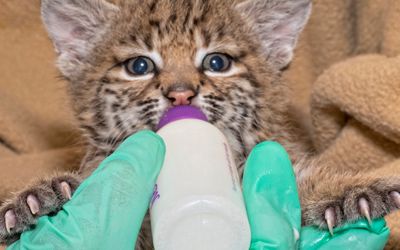Discover Professional Solutions in Wildlife Rescue Burlington for Resident Animals
Discover Professional Solutions in Wildlife Rescue Burlington for Resident Animals
Blog Article
Efficient Wild Animals Removal Approaches for a Peaceful Home Setting
In the quest of maintaining a peaceful living room, homeowners typically encounter the challenge of wild animals breaches, which can interfere with the peace of their atmosphere. Applying reliable wildlife removal approaches requires a nuanced understanding of both gentle exclusion methods and preventative actions.
Identifying Common Wildlife Intruders
Identifying typical wild animals trespassers is an essential very first action in reliable wildlife administration. Understanding the particular species that regularly penetrate property and industrial rooms enables homeowner and wild animals specialists to execute targeted methods for minimizing prospective damage and health and wellness threats. Usual trespassers usually include raccoons, squirrels, bats, and numerous types of birds and rodents, each bringing special obstacles.
Raccoons, as an example, are recognized for their mastery and can create considerable architectural damage while looking for food or shelter. Squirrels, with their tendency for gnawing, can harm electric circuitry, posing fire hazards. Bats, while advantageous for controlling insect populations, can become a hassle when they roost in attic rooms, possibly spreading diseases such as histoplasmosis. Birds, consisting of sparrows and pigeons, typically create unsanitary problems with their droppings, causing architectural deterioration and health and wellness concerns. Rats, such as computer mice and rats, are well-known for their rapid recreation and ability to penetrate small openings, posturing significant health dangers because of their ability to spread out conditions.
Humane Exclusion Strategies
Recognizing the usual wildlife trespassers is the foundation upon which reliable exemption techniques are built. Identifying types such as squirrels, birds, and raccoons aids in developing humane exclusion techniques customized to certain actions and entry methods. Exclusion is a preventative technique aimed at denying wild animals accessibility to residential or commercial properties and homes, thus decreasing the demand for more invasive measures.
The keystone of gentle exclusion entails securing potential entry points. This includes repairing holes in structures, roofings, and walls, along with mounting chimney caps and air vent covers. For smaller invaders like mice and bats, making use of materials such as steel wool and caulk to seal spaces is necessary. Furthermore, making sure that windows and doors are secure, and that screens are undamaged, can better prevent entrance.
Setting up ultrasonic tools or motion-activated lights can prevent nocturnal wild animals. These exclusion approaches not only protect the home setting but likewise value the wild animals, allowing them to prosper in their all-natural environments without harm.
Safe Trapping Methods
When exemption methods are not enough, secure trapping approaches become a needed recourse in wild animals monitoring. Trapping, when implemented appropriately, offers a humane and effective ways of dealing with an instant wildlife trouble while ensuring very little stress and harm to the animal. This technique needs an understanding of both the behavior of the target species and the honest considerations involved in wildlife handling.
These catches should be checked often to protect against undue stress and anxiety or injury to the captured wild animals. It is essential to adhere to neighborhood regulations pertaining to capturing and moving to guarantee conformity with legal standards and wildlife conservation concepts.
Additionally, bait option and positioning her explanation are essential elements in ensuring successful trapping. Lure ought to be selected based on the nutritional choices of the target species and tactically positioned to draw the animal into the catch. When trapped, the pet should be managed with treatment, utilizing protective gear if necessary, to assist in risk-free transport and launch, thus preserving a well balanced environment and a peaceful home atmosphere.
Preventive Home Modifications
While safe trapping approaches address immediate wildlife problems, lasting options often require preventative home adjustments to hinder animals from entering human areas. Executing these alterations not just boosts the security and convenience of your living setting but also lowers the likelihood of future wild animals breaches.
A critical element of preventative strategies is sealing prospective entrance points. This includes examining and fixing any type of spaces or splits in the foundation, walls, and roofing, as these can end up being accessibility courses for wild animals. Installing smokeshaft caps and fixing damaged vents can protect against birds, bats, and rodents from obtaining entry. Likewise, securing doors and home windows with weather stripping and harmonize screens adds an added layer of security.
Landscaping alterations can likewise function as effective deterrents. Trimming tree branches more information that overhang the roofing and removing debris piles can get rid of paths and environments that draw in wildlife. Keeping a tidy backyard by protecting trash can and compost piles inhibits scavengers such as raccoons and opossums.

## When to Call Experts
Expert treatment comes to be critical in circumstances where wildlife issues exceed the range of DIY options. House owners might experience scenarios where the complexity or threat of the wildlife problem requires expert competence.
Furthermore, problems including protected or threatened species require a nuanced method to abide by lawful policies. Specialists are geared up with the essential licenses and recognize the lawful frameworks controling the handling of such types. This guarantees that elimination is performed fairly and within lawful borders.

Last but not least, when wildlife poses a consistent issue in spite of duplicated do it yourself efforts, specialist services can provide extensive inspection and long-lasting services tailored to avoid reoccurrence - wildlife removal Burlington. Their knowledge not just resolves the immediate concern but likewise safeguards the home environment in the future
Final Thought
Applying reliable wild animals removal strategies is essential for maintaining a peaceful home setting. With each other, these methods produce a harmonious living room complimentary from wildlife disturbances.

These exemption techniques not only safeguard the home atmosphere but also appreciate the wildlife, enabling them to flourish in their all-natural habitats without harm.
Implementing effective wildlife elimination approaches is vital for keeping a tranquil home atmosphere.
Report this page